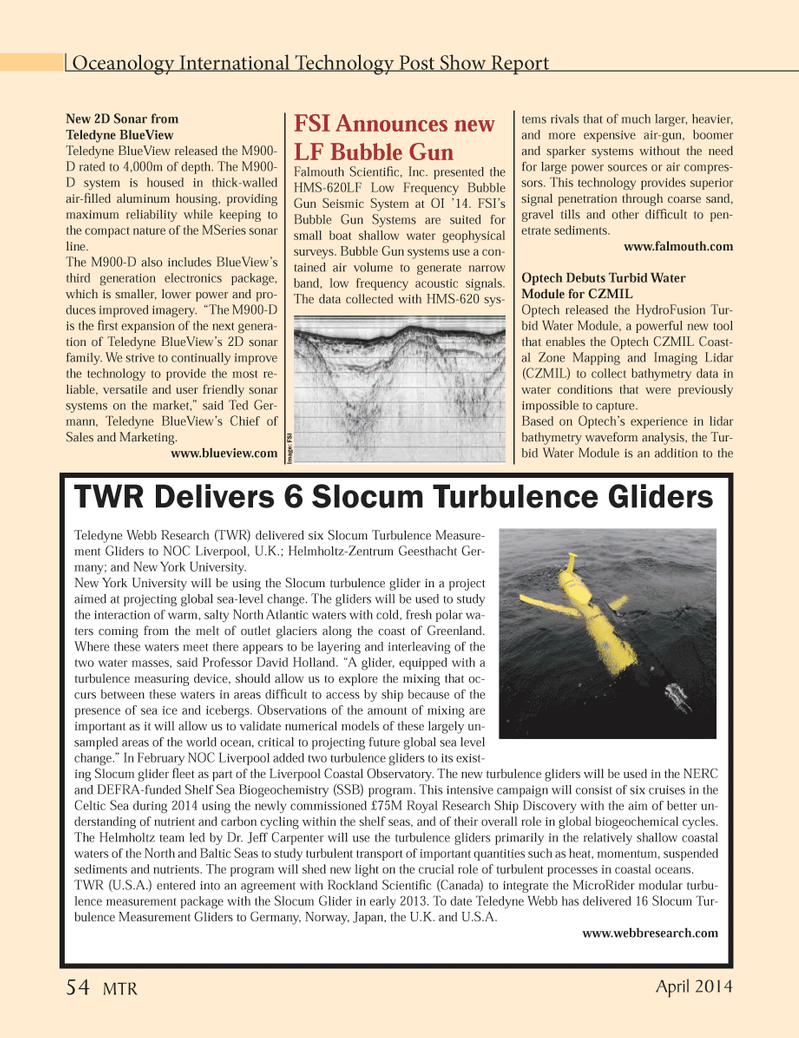
Page 54: of Marine Technology Magazine (April 2014)
Offshore Energy
Read this page in Pdf, Flash or Html5 edition of April 2014 Marine Technology Magazine
Oceanology International Technology Post Show Report
New 2D Sonar from
Teledyne BlueView
Teledyne BlueView released the M900-
D rated to 4,000m of depth. The M900-
D system is housed in thick-walled air-fi lled aluminum housing, providing maximum reliability while keeping to the compact nature of the MSeries sonar line.
The M900-D also includes BlueView’s third generation electronics package, which is smaller, lower power and pro- duces improved imagery. “The M900-D is the fi rst expansion of the next genera- tion of Teledyne BlueView’s 2D sonar family. We strive to continually improve the technology to provide the most re- liable, versatile and user friendly sonar systems on the market,” said Ted Ger- mann, Teledyne BlueView’s Chief of
Sales and Marketing. www.blueview.com
FSI Announces new
LF Bubble Gun
Falmouth Scientifi c, Inc. presented the
HMS-620LF Low Frequency Bubble
Gun Seismic System at OI ’14. FSI’s
Bubble Gun Systems are suited for small boat shallow water geophysical surveys. Bubble Gun systems use a con- tained air volume to generate narrow band, low frequency acoustic signals.
The data collected with HMS-620 sys- tems rivals that of much larger, heavier, and more expensive air-gun, boomer and sparker systems without the need for large power sources or air compres- sors. This technology provides superior signal penetration through coarse sand, gravel tills and other diffi cult to pen- etrate sediments. www.falmouth.com
Optech Debuts Turbid Water
Module for CZMIL
Optech released the HydroFusion Tur- bid Water Module, a powerful new tool that enables the Optech CZMIL Coast- al Zone Mapping and Imaging Lidar (CZMIL) to collect bathymetry data in water conditions that were previously impossible to capture.
Based on Optech’s experience in lidar bathymetry waveform analysis, the Tur- bid Water Module is an addition to the
TWR Delivers 6 Slocum Turbulence Gliders
Teledyne Webb Research (TWR) delivered six Slocum Turbulence Measure- ment Gliders to NOC Liverpool, U.K.; Helmholtz-Zentrum Geesthacht Ger- many; and New York University.
New York University will be using the Slocum turbulence glider in a project aimed at projecting global sea-level change. The gliders will be used to study the interaction of warm, salty North Atlantic waters with cold, fresh polar wa- ters coming from the melt of outlet glaciers along the coast of Greenland.
Where these waters meet there appears to be layering and interleaving of the two water masses, said Professor David Holland. “A glider, equipped with a turbulence measuring device, should allow us to explore the mixing that oc- curs between these waters in areas diffi cult to access by ship because of the presence of sea ice and icebergs. Observations of the amount of mixing are important as it will allow us to validate numerical models of these largely un- sampled areas of the world ocean, critical to projecting future global sea level change.” In February NOC Liverpool added two turbulence gliders to its exist- ing Slocum glider fl eet as part of the Liverpool Coastal Observatory. The new turbulence gliders will be used in the NERC and DEFRA-funded Shelf Sea Biogeochemistry (SSB) program. This intensive campaign will consist of six cruises in the
Celtic Sea during 2014 using the newly commissioned £75M Royal Research Ship Discovery with the aim of better un- derstanding of nutrient and carbon cycling within the shelf seas, and of their overall role in global biogeochemical cycles.
The Helmholtz team led by Dr. Jeff Carpenter will use the turbulence gliders primarily in the relatively shallow coastal waters of the North and Baltic Seas to study turbulent transport of important quantities such as heat, momentum, suspended sediments and nutrients. The program will shed new light on the crucial role of turbulent processes in coastal oceans.
TWR (U.S.A.) entered into an agreement with Rockland Scientifi c (Canada) to integrate the MicroRider modular turbu- lence measurement package with the Slocum Glider in early 2013. To date Teledyne Webb has delivered 16 Slocum Tur- bulence Measurement Gliders to Germany, Norway, Japan, the U.K. and U.S.A. www.webbresearch.com
Image: FSI
April 2014 54 MTR
MTR #3 (50-64).indd 54 4/9/2014 2:16:12 PM

 53
53

 55
55
